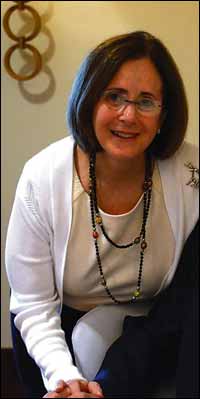|
PROFILE Helping those who rescued Jews is 'best job in world' | |
Stanlee - named after her Uncle Stanley, who was killed in 1944 in the Battle for Rome - should know, for the sprightly 69-year-old has held a host of jobs. Coming from a poor American Jewish family and university educated on scholarships, Stanlee heeded the words of the late John F Kennedy when he said: "Ask not what your country can do for you, but what you can do for your country." His words inspired her to serve the US government, working in the biomedical research arm of the National Institutes of Health, which provides public health to the poor. Then, four years later, much to her parents' horror, in 1971 Stanlee quit her job to travel. She said: "My parents went through the Depression. They were horrified. If you had a government job, you didn't quit. But I had never travelled. It was time to move on." Stanlee flew to Amsterdam, from where she went to the UK, fleeing hastily from the Troubles in Northern Ireland to tour Eire. From there, she proceeded to Italy where she joined her mother in visiting her late uncle's grave. Stanlee headed to Israel with her mother, who was national director of American Friends of Magen David Adom. Stanlee remained in Israel for a year, working for MDA, arranging for Americans to see the ambulances they had donated. Back in New York, she returned to Federal Government, vetting research and training grants. She then became chief of staff to Democrat and Republican political appointees for 10 years. It was then that she was hired by the Community Food Bank of New Jersey director to get Extra Helping off the ground. She explained: "It was New Jersey's first prepared food transfer programme. "I would go to university dining halls before the holidays and ask them to put the food they would throw out on trays and freeze it." She set up feeding programmes in 18 of New Jersey's 21 counties. She also established the first kosher prepared-food transfer programme. Stanlee said: "People think there are no Jewish poor. But they are hidden. I went to kosher caterers, who always over-prepare, and asked them to make 20 extra portions." These, she said, went to the Jewish elderly who only received day centre meals on weekdays and not on Shabbat or Sunday. She said: "My son and his school friends would go to the elderly before Shabbat, light candles and make kiddush for them." Stanlee joined the Jewish Foundation for the Righteous in 1992. The organisation was founded by Rabbi Harold Schulweis on the principle of hakarot hatov (searching out and recognising non-Jews who risked their lives and those of their families to save Jews). Many of the rescuers, especially those living in eastern Europe, were very poor. Stanlee said: "At its height, the JFR was funding more than 1,800 people in 34 countries." As the rescuers reach the end of their lives, that number has now decreased to 585 in 21 countries, mostly in Poland, Ukraine, Lithuania, Belarus, Hungary, Russia and the Czech Republic. JFR are informed about rescuers who are in difficult circumstances by Yad Vashem and by the survivors they rescued. The organisation is committed to spending almost $2m a year on funding the rescuers - a sum Stanlee raises from an annual dinner, as well as from her triathlon sponsorship. The annual dinners and reunion events in Poland often provide opportunities for rescuers to be reunited with those they saved and their families. At last year's New York dinner, an observant Jew, Dr Leon Gersten, originally from Poland, but now living in Long Island, New York, was reunited with his rescuer Polish Catholic Czeslaw Polziec. Dr Gersten has five children, 34 grandchildren and 12 great-grandchildren. Stanlee, who rises at 5.30am to practise swimming for her fundraising triathlons, said: "Czeslaw was able to see that all these Jews were alive because his family took in Jews during the Holocaust." Stanlee visited London last month after a kosher luncheon for rescuers at the Marriot Hotel Warsaw, attended by the American and Israeli ambassadors, the Chief Rabbi of Poland, the Polish consul general to New York and 40 rescuers and their guests. Stanlee said: "The rescuers don't go out a lot. We celebrated four birthdays, including for a 97 and 95-year-old." On her European trip, Stanlee also did a film shoot of rescuers in their east European homes and at Auschwitz to be screened at next year's New York dinner as well as to be used in Holocaust education in the USA. The purpose of Stanlee's visit to London was an innovative Holocaust education project, which she is organising in conjunction with the State Museum of Auschwitz-Birkenau, the London Institute of Education and London's Wiener Library. With the help of these three institutions, she is producing concentration camp artefact boxes to be used in Holocaust education throughout the USA. She said: "Most American students will never step foot in a German concentration camp." Through these artefact boxes, Stanlee is hoping to take the reality of the Holocaust to American students who will be able to examine the household and culinary items that Jewish families brought to the concentration camps, thinking they were going east to work, as well as objects such as prison garments and, possibly, a can of the poisonous Zyklon B used in the camps. Stanlee may have done many worthwhile jobs in her life, but in her mind, recompensing Holocaust rescuers and teaching young Americans never to forget the Holocaust, beats them all.
|
